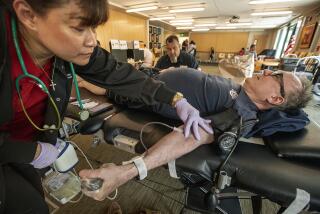Patient’s Plight Draws Calls About Marrow Donor Testing
- Share via
Moved by the plight of Tarzana leukemia patient Marc Smith, who beat the odds of finding a person with compatible bone marrow only to have his hopes for a transplant dashed, thousands of people inquired Wednesday about being tested to become donors themselves.
But the outpouring of concern is too late to help Smith, 36, who on Tuesday began preparatory chemotherapy for a riskier transplant procedure using his own marrow.
Smith, who has three young children, is in the late stages of the disease and cannot wait any longer to find a matching donor.
Medical professionals say the volunteers who came forward because of the media coverage of Smith’s story could benefit some of the 9,000 patients currently searching for marrow donors, as well as those patients who might need transplants in the future.
“Nobody who is tested tomorrow can possibly be Smith’s donor,” said Dr. Rudolph Brutoco, who is on the board of directors of the National Marrow Donor Program.
At a minimum, it takes four to six weeks to complete the laboratory testing to determine a person’s bone marrow type from a blood sample.
Smith, who doctors said at the end of January only had a month to live, began receiving chemotherapy for an autologous transplant on Tuesday, the day he learned that a woman whose bone marrow is compatible with his had decided not to donate her marrow for transplant into Smith.
The autologous transplant therapy involves removing some of the patient’s bone marrow, using drugs or radiation to kill the diseased cells, and then returning it to the leukemia sufferer’s body. It has a lower success rate than using bone marrow from a compatible donor. Leukemia is a disease of the blood-making cells in the bone marrow.
Smith, a patient at the Fred Hutchinson Cancer Center in Seattle, had been scheduled to have the autologous transplant at the beginning of February, after efforts to find a donor with compatible marrow proved fruitless.
But hours before he was scheduled to begin the preparatory chemotherapy, Smith was notified that a woman whose marrow might match his had been identified.
Smith’s doctors advised him that he was running out of time and should go ahead with the autologous transplant. He persuaded them to wait for additional testing to see if the woman was a perfect match. He said he was overjoyed when he learned late last month that her marrow was compatible with his.
But Smith was informed Tuesday that the woman had decided not to undergo the harvesting procedure to become a donor.
Because of strict confidentiality policies, Smith does not know the woman and has not been told officially why she elected not to be a donor. He said hospital officials have indicated to him that her relatives opposed her participation and persuaded her not to do it.
The chance of finding two people with compatible bone marrow is between 1 in 15,000 and 1 in 20,000.
On Wednesday more than 2,000 people across the country contacted the Life-Savers Foundation, a Covina-based organization that recruits people to be tested to become bone marrow donors, said organization spokeswoman Susan Rafkin.
Dozens more called the Fred Hutchinson Center, where Smith is a patient, asking how they could become donors, said Lori Hubbard, coordinator of that hospital’s Unrelated Donor Program. Hubbard said donor centers nationwide also received phone calls from people who heard Smith’s story.
Although it is too late for Smith, Rafkin said: “We will test everyone. Every single one of us has the gift of life for someone, whether it is now or two years down the road.”
After volunteers are tested, their names and marrow types are placed in the National Marrow Registry, a resource for patients needing bone marrow transplants.
Fewer than 100,000 people are now listed in the registry. Rafkin said 24 people die each day because they are unable to find compatible matches.
In Walnut, the parents of a 17-year-old girl suffering from leukemia are having another child in the hopes that the baby’s marrow will be compatible with that of their older daughter. There is a 25% chance that two siblings will have compatible bone marrow.
In two other area cases, 10-year-old Adam Brock, also of Tarzana and a friend of Smith’s, and Dean Schmitt, 15, of Thousand Oaks are searching for bone marrow donors to help them fight off leukemia.
GROUP SEEKS DONORS
Life-Savers match bone marrow donors and leukemia patients. View. E5A
More to Read
Sign up for Essential California
The most important California stories and recommendations in your inbox every morning.
You may occasionally receive promotional content from the Los Angeles Times.













